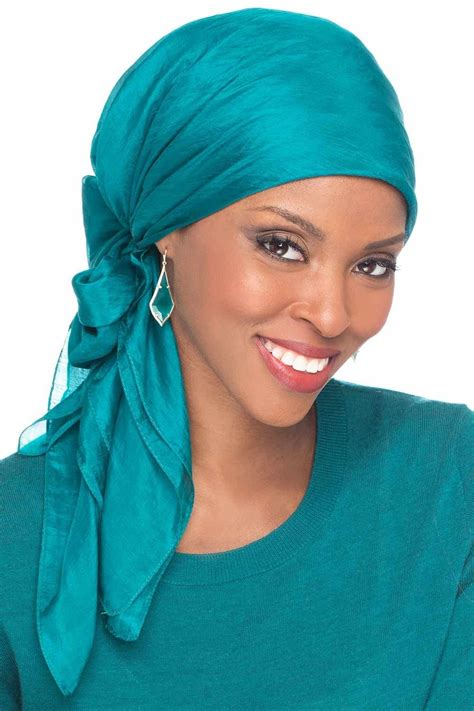Cancer treatments, such as chemotherapy and radiation, can often lead to hair loss, which can be a distressing experience for many patients. Head scarves and wraps provide a comfortable, stylish, and supportive way to cover up hair loss during treatment and recovery. This comprehensive guide will explore the various styles, materials, and benefits of head scarves and wraps specifically designed for cancer patients.

1. Pre-Tied Bandanas
Pre-tied bandanas are a convenient option that eliminate the need for complicated tying techniques. They come in a variety of colors, patterns, and fabrics, making them easy to match with any outfit.
2. Turbans
Turbans are a versatile and elegant choice that offers full coverage for the head. They can be made from a range of fabrics, including soft cotton, luxurious silk, and breathable linen.
3. Chemo Caps
Chemo caps are specifically designed for cancer patients undergoing chemotherapy. They are made from soft, comfortable materials that minimize friction and irritation on sensitive scalps.
4. Head Wraps
Head wraps are long pieces of fabric that can be wrapped around the head in a variety of ways. They provide a customizable level of coverage and can be used to create unique and stylish looks.
5. Beanie Hats
Beanie hats offer cozy warmth and versatility. They can be worn alone or under scarves or wraps for added coverage.
The choice of material for a head scarf or wrap depends on individual comfort and preferences. Some of the most common materials used include:
1. Cotton
Cotton is a breathable, natural fiber that is soft and comfortable against the skin. It absorbs moisture efficiently, making it ideal for warm climates.
2. Bamboo
Bamboo is an incredibly soft and durable fabric that is also hypoallergenic and moisture-wicking. It is a good choice for those with sensitive skin.
3. Silk
Silk is a luxurious and lightweight fabric that provides a smooth and cooling sensation. It is also moisture-absorbent and breathable.
4. Linen
Linen is a natural fiber that is known for its breathability and wrinkle resistance. It is an excellent choice for summer wear.
5. Synthetic Fibers
Synthetic fibers, such as nylon and polyester, are often used in blend with natural fibers to create durable, moisture-wicking head scarves and wraps.
Head scarves and wraps for cancer patients offer a multitude of benefits, both practical and emotional:
1. Coverage and Concealment
Head scarves and wraps provide a comfortable and discreet way to cover hair loss, allowing patients to feel more confident and less self-conscious.
2. Protection from the Elements
Head scarves and wraps can protect the scalp from the sun, cold, wind, and other environmental factors. This is especially important for patients undergoing radiation therapy, which can make the scalp more sensitive.
3. Moisture Absorption
Many head scarves and wraps are made from moisture-wicking fabrics that help absorb sweat and keep the head cool and comfortable.
4. Comfort and Support
Head scarves and wraps can provide gentle pressure on the scalp, which can alleviate discomfort and promote relaxation.
5. Style and Confidence
Head scarves and wraps come in a wide range of colors, patterns, and styles, allowing patients to express their individuality and boost their confidence during treatment.
Head scarves and wraps for cancer patients can be found at a variety of locations, including:
1. Medical Supply Stores
Medical supply stores carry a wide selection of head scarves and wraps specifically designed for cancer patients.
2. Cancer Treatment Centers
Many cancer treatment centers offer head scarves and wraps as part of their support services.
3. Online Retailers
Numerous online retailers specialize in head scarves and wraps for cancer patients.
4. Local Support Groups
Local support groups often provide head scarves and wraps as part of their peer support services.
Here are some helpful tips for choosing and wearing head scarves and wraps for cancer patients:
1. Choose Soft and Comfortable Materials
Opt for head scarves and wraps made from soft and comfortable materials that will not irritate the scalp.
2. Select Breathable Fabrics
Choose breathable fabrics that allow air to circulate and keep the head cool and comfortable.
3. Consider Your Personal Style
Select head scarves and wraps that complement your personal style and make you feel confident.
4. Experiment with Different Tying Techniques
There are numerous ways to tie head scarves and wraps. Experiment with different techniques to find the one that suits you best.
5. Use Accessories
Use accessories, such as pins and hair clips, to secure head scarves and wraps and add a personal touch.
1. How often should I wash my head scarf or wrap?
Wash your head scarf or wrap after each use to maintain hygiene and prevent bacteria buildup.
2. Can I wear head scarves or wraps all the time?
Yes, you can wear head scarves or wraps as often as you like for comfort, coverage, and style.
3. Are there any special head scarves or wraps for cancer patients with sensitive scalps?
Yes, there are head scarves and wraps made with soft, hypoallergenic materials specifically designed for cancer patients with sensitive scalps.
4. Where can I find support for wearing head scarves or wraps?
There are numerous support groups and online communities where cancer patients can connect with others who are wearing head scarves or wraps.
Head scarves and wraps for cancer patients are an invaluable source of comfort, support, and style during treatment and recovery. By choosing the right materials, styles, and accessories, patients can find head scarves and wraps that meet their individual needs and preferences. Remember, head scarves and wraps are a way to express yourself and regain control during a challenging time.
